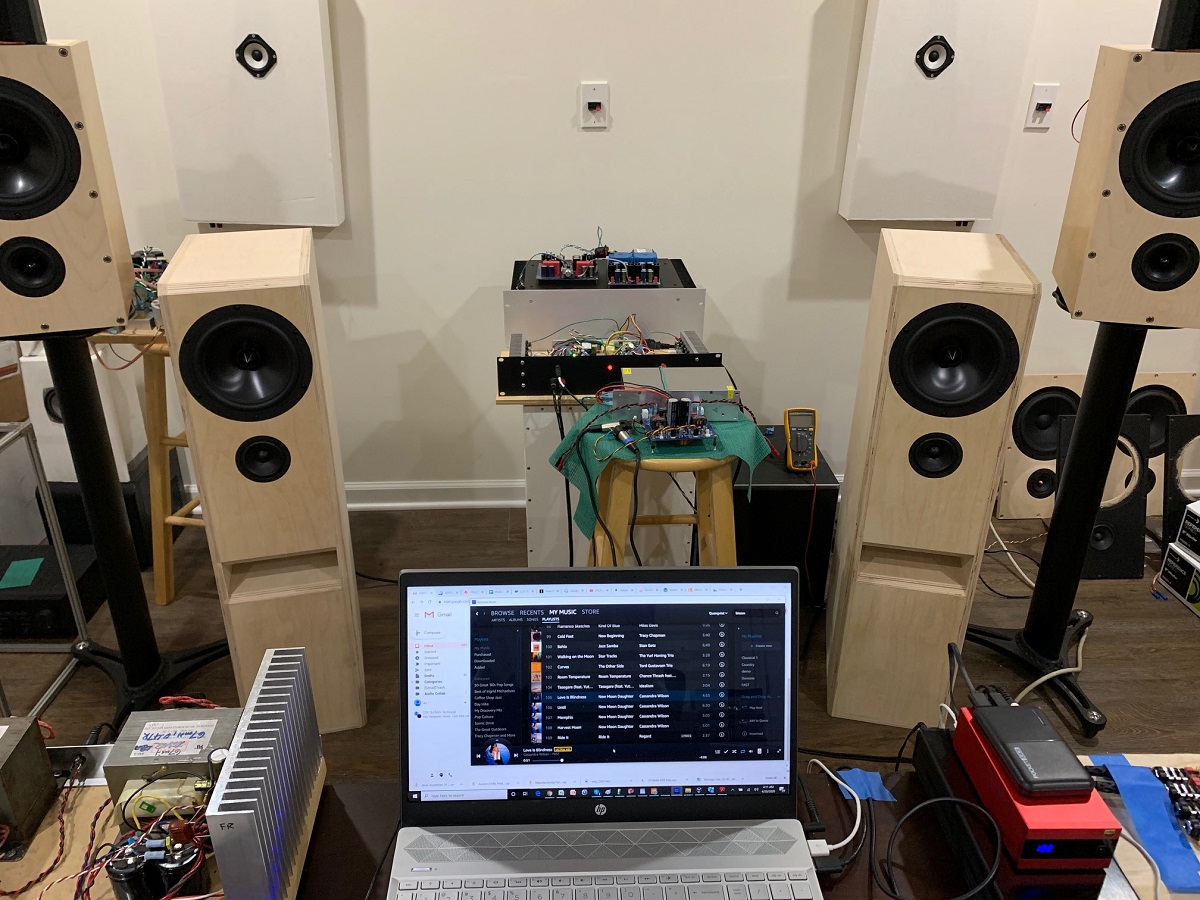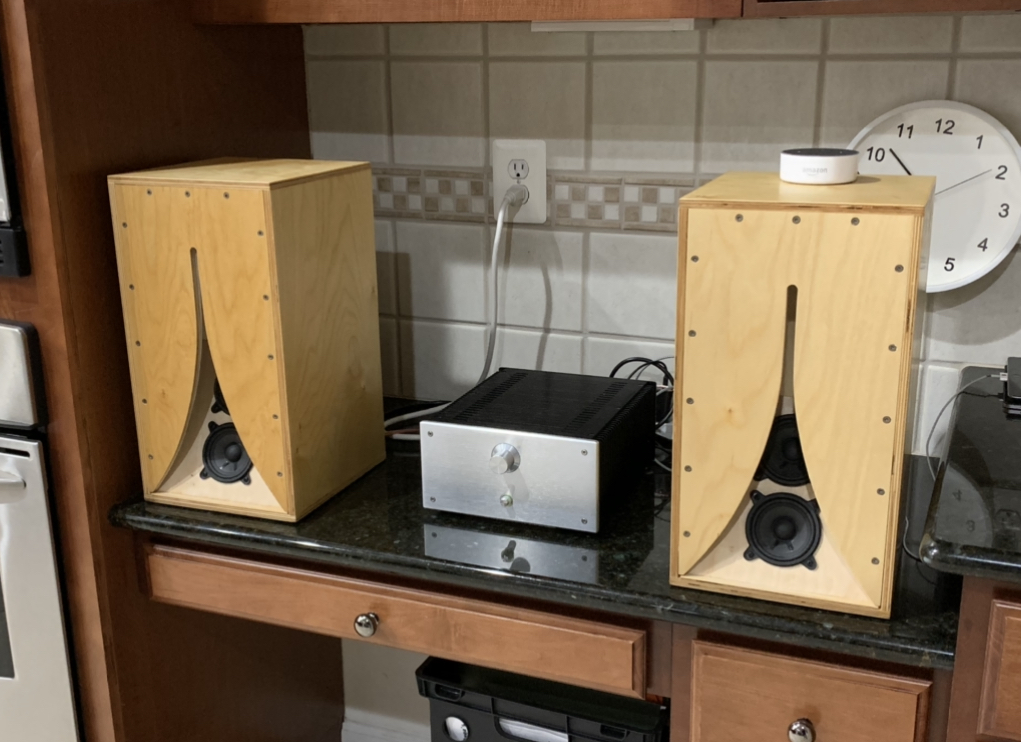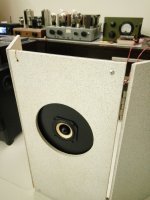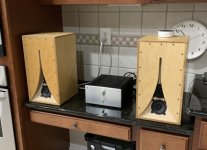Flat response in the box. But room response is also important. One has to keep in mind that any raising of the on-axis to compensate for the BS, means that the room response will also have a comserate risa in the room response. One has to strike a balance that works in your room.
dave
dave
Let's remember that we are looking at drivers that will measure the flattest, as these are intended to be monitors for checking mixes.
So, any driver that offers a wild frequency ride, or falls short in the treble, shouldn't be suggested.
Well, that narrows it down to very few drivers, unless DSP is used to compensate.
There was no mention of dsp in the OP, so, depending on budget, the choices are mostly the 10F or B80 at the higher end of the budget, and the TC/TG9 towards the lower end.
I also really like the SB65, but it doesn't have the lush sound of the paper cones, which excel with voices.
But the SB65 is absolutely stunning with stringed and woodwind instruments.
That is correct......a driver that is extremely flat and revealing in the critical midrange. Such a driver on it’s own allows for a better workflow....quicker identification of offensive resonances that require surgical eQ and a more open view into compression artifacts and tonal balance resulting.
The driver HAS to be able to handle some power on its own in fullrange mode......can’t succumb to power compression with dynamic peaks of 90db......I think that rules out the SB.....maybe even the Fountek. I know the ScanSpeak can take it and the RS100 too. I’ve seen some favor here and elsewhere for the Faital 3 as well and REALLY good stuff about the Visaton.........but I’m torn on the tilted rising response which might make for a dark mix played elsewhere
For you folks here, it might be difficult here to align your listening tastes with the qualities desired in a mix session. I’d add that a quality often criticized is the inherent poor off axis response.....a plus for mixing in a small space and the reduced room reflections.....when i’m mixing, i’m on axis and generally don’t move outside of a 5 degree window unless examining stereo separation and mid/side separation.
DDR? 😕
…
I'm assuming this is a *"low-level detail"/clarity thing, particularly with regard to apparent reproduced space and notably depth.
Downward Dynamic Range. A term from a luminary in the business to remove all the fancy audiophile words used to try to describe the same thing.
The ability of a device to be able to reproduce (not lose) the very small low level information even in the presence of much larger signal. The stuff that lets you tell what king of guitar it is, the subtlies of a voice, the critical information required to create the illusion of a soundstage/image.
dave
Flat response in the box. But room response is also important. One has to keep in mind that any raising of the on-axis to compensate for the BS, means that the room response will also have a comserate risa in the room response. One has to strike a balance that works in your room.
dave
Again, in my case......i’m In the nearfield on axis at around 1 meter.....in a VERY well treated space......4” mineral wool on 60 percent of the wall area and an overhead soundcloud with another 4” layer. Rear wall is a combo of absorption and tunable diffractors. Bass below 150hz is always a problem no matter how well the room is treated.......you just have to know your space and work with it.
NO MORE DSP!!!!!!!.......there’s already a ton of filter ringing and such from DSP and plug ins in the box which have to be brought back to life with analog tape saturation. Tape and Vinyl will ALWAYS sound better than the best digital out there for the rich harmonic content......it’s the sauce our brains crave and it’s needed over the dry DSP grown noodles we create in the modern world of cost and convenience........when it comes to recording, calibrating a 30 year old 24 track tape machine just isn’t a viable option.
DDR: it's absurd.
It doesn't in and of itself describe the result to a person who has never heard of it before.
Low Level Detail does.. and it's a common phrase, audiophool or not.
Note that in some instances you aren't actually loosing that clarity with the drivers you like, but rather are gaining it relative to the rest of the signal.
Perceptually you "track" the peaks in the "hash".
It doesn't in and of itself describe the result to a person who has never heard of it before.
Low Level Detail does.. and it's a common phrase, audiophool or not.
Note that in some instances you aren't actually loosing that clarity with the drivers you like, but rather are gaining it relative to the rest of the signal.
Perceptually you "track" the peaks in the "hash".
Dave’s DDR has merit within the overall listening experience if you consider the flavor of properly introduced harmonic distortion......a driver CAN contribute such a flavor by design.....cone material, BL, Q........and the dust cap......often overlooked in our world as we measure close mic and on center. Measuring off center of the driver and more towards the area between the cone edge and dust cap can reveal a whole new level of stuff going on............but DDR is something I would want in a monitor.......i want to know sufficient analog flavor and harmonics are coming from the source and not required by the driver to sound rich and warm.
Again, in my case......i’m In the nearfield on axis at around 1 meter..
You shouldn't need any pressure increase for baffle-step compensation assuming the driver-on-baffle result is flat.
Remember, when you are looking at your driver that you always need to consider it in relation to the baffle and the driver's placement on that baffle.
Additionally, look at the objective performance within the entire pass-band you are using it for. Not just at you typical listening spl, but also at higher spl's in case you need that extra bit of spl (..either of loudness or dynamic range, or both of course).
Last edited:
Dave’s DDR has merit within the overall listening experience if you consider the flavor of properly introduced harmonic distortion......a driver CAN contribute such a flavor by design.....cone material, BL, Q........and the dust cap......often overlooked in our world as we measure close mic and on center. Measuring off center of the driver and more towards the area between the cone edge and dust cap can reveal a whole new level of stuff going on............but DDR is something I would want in a monitor.......i want to know sufficient analog flavor and harmonics are coming from the source and not required by the driver to sound rich and warm.
This is a good reason for why "DDR" is a poor naming convention. 😉
He isn't talking about harmonics per se, and particularly not in a driver.
Rather he is talking about the extra bit of detail that heighten's the response of the listener to better judge the harmonics of any given reproduced *source (..as well as space/depth/image-size etc.).
It's a linear effect (..though it's not an effect you'd see from an averaged response), and one that also has a particular phase component. AKA "sounds real".
*source could be the difference between a good violin and cheap one (..which not incidentally has very similar characteristics between drivers).
Last edited:
Member
Joined 2006
How about giving Dynavox LY401F 4" a try for $20 @PE ? 🙂
Timothy Feleppa's Pages: Speaker Measurements - Midrange/Fullrange Speakers 4" and smaller
I found it a more favoribly sounding fullrange than TC9 on a midsized OB shown.
And here is a small BR box plan for this driver (Fo = 53Hz).
Here the double bass reflex enclosure provides a good low frequency extension, F3 ~ 50Hz and F10 ~ 42Hz.
Lyeco LY401F DIY Double Bass Reflex Enclosure
Timothy Feleppa's Pages: Speaker Measurements - Midrange/Fullrange Speakers 4" and smaller
I found it a more favoribly sounding fullrange than TC9 on a midsized OB shown.
And here is a small BR box plan for this driver (Fo = 53Hz).
Here the double bass reflex enclosure provides a good low frequency extension, F3 ~ 50Hz and F10 ~ 42Hz.
Lyeco LY401F DIY Double Bass Reflex Enclosure
Attachments
Last edited:
Are you saying there is always going to be audible distortions in the chain before the speaker and you prefer some forms to others?NO MORE DSP!!!!!!!.......there’s already a ton of filter ringing and such from DSP and plug ins in the box which have to be brought back to life with analog tape saturation. Tape and Vinyl will ALWAYS sound better than the best digital out there for the rich harmonic content......it’s the sauce our brains crave and it’s needed over the dry DSP grown noodles we create in the modern world of cost and convenience........when it comes to recording, calibrating a 30 year old 24 track tape machine just isn’t a viable option.
This is a good reason for why "DDR" is a poor naming convention.
take that up with Allen Wright.
I think you are missing the whole jist of the concept.
dave
Rather he is talking about the extra bit of detail that heighten's the response of the listener to better judge the harmonics of any given reproduced *source (..as well as space/depth/image-size etc.).
It's a linear effect (..though it's not an effect you'd see from an averaged response), and one that also has a particular phase component. AKA "sounds real".
Its not an effect. It is th epreservation of low level information.
dave
The way to see low level detail is simple: you need a driver with high sensitivity and low harmonic distortion. I have heard this with full range drivers like TC9 in a tractrix horn which couples the driver so efficiently that only 40microns of cone motion is required for 90dB SPL, hence distortion is exceedingly low while SPL is very high. That’s the most powerful way to retrieve low level detail. Or a driver that can be driven to higher SPL with still low harmonic distortion. These are measurable qualities and based on that, the ScanSpeak 10F is very hard to beat. Plus it is very smooth and flat. It has a rising response but in a properly designed cabinet, it measures flat if used slightly off axis. For example, on my 10F/RS225 reference FAST monitors, the woofer axis is the main axis and the 10F is slightly off axis below level. In a tapered PMC style TL, this has produced one of the best sounding speakers I have ever heard. The low level detail is extremely good. I have compared it against the B80 and also with a Heil AMT. the AMT add “air” but I feel that is artificial sounding. Long term listening tests still shows that the 10F is the king of the midrange clarity.
Here it is in the new TL speakers. These are in the top 3 of the best speakers I have heard anywhere and at any cost including $50k commercial stuff at audio boutiques and shows. Btw, low level detail definitely is affected a lot by the quality of your amplifier, your preamp, and your DAC.
Some testing between a 100w Class AB (VHEX+) and the Alpha Nirvana 40w Class A amp here, and Sanskrit 10 DAC running from 192kHz 24bit FLAC will have an huge impact on low level detail vs 44kHz 16bit CD. The Alpha Nirvana provides a huge boost in clarity and detail because of the Class A operation and it has a low native 0.002% THD and an natural sounding H2 dominant profile with a monotonically descending higher order distortion.

Here it is in the new TL speakers. These are in the top 3 of the best speakers I have heard anywhere and at any cost including $50k commercial stuff at audio boutiques and shows. Btw, low level detail definitely is affected a lot by the quality of your amplifier, your preamp, and your DAC.
Some testing between a 100w Class AB (VHEX+) and the Alpha Nirvana 40w Class A amp here, and Sanskrit 10 DAC running from 192kHz 24bit FLAC will have an huge impact on low level detail vs 44kHz 16bit CD. The Alpha Nirvana provides a huge boost in clarity and detail because of the Class A operation and it has a low native 0.002% THD and an natural sounding H2 dominant profile with a monotonically descending higher order distortion.
Last edited:
Wow, why can't we all be friends...
FWIW, it seems that Dave has a bit of a vested interest in the MA drivers he is touting...though that might be a little harsh, and I'm sure they are good. I hasten to point out that I haven't heard any of them, and that he knows far more about the subject in general than I do, I'm sure. But so does X...
You will find elsewhere on this site that I am a big fan of the FaitalPro drivers as well, they really do have a remarkably flat response, and high sensitivity, but the reason I really go for them is that given that in the UK at least you can get the 3FE25 for £21/pair, I think they run away with the top prize for price/performance ratio.
I have also been intrigued by the Dynavox LY301F and LY402F, they seem to have remarkable low end performance for such small drivers, but unfortunately they are less available in the UK, so I haven't sprung for a pair yet. I would love to know how they would work in Bjorn's TABAQ design, I bet you could get some serious bass (for a 3/4in driver)
But my vote in this poll went to other, for the Faitalpro 3FE25...
FWIW, it seems that Dave has a bit of a vested interest in the MA drivers he is touting...though that might be a little harsh, and I'm sure they are good. I hasten to point out that I haven't heard any of them, and that he knows far more about the subject in general than I do, I'm sure. But so does X...
You will find elsewhere on this site that I am a big fan of the FaitalPro drivers as well, they really do have a remarkably flat response, and high sensitivity, but the reason I really go for them is that given that in the UK at least you can get the 3FE25 for £21/pair, I think they run away with the top prize for price/performance ratio.
I have also been intrigued by the Dynavox LY301F and LY402F, they seem to have remarkable low end performance for such small drivers, but unfortunately they are less available in the UK, so I haven't sprung for a pair yet. I would love to know how they would work in Bjorn's TABAQ design, I bet you could get some serious bass (for a 3/4in driver)
But my vote in this poll went to other, for the Faitalpro 3FE25...
I agree that 3FE25 are wonderful. I and even the rest of the family, listen to them daily probably more than any other driver as they are in the 0.53x Karlsonators in the kitchen. I use parallel 16ohm 3FE25’s for some incredibly sensitive 8ohm speakers. They definitely deserve recognition for great smooth sound with nice reach, low distortion, and unbeatable value.
Here they are - the most popular speaker in the house.

Amp is Hugh Dean’s superb sounding Deltic 65w Class AB.
Here they are - the most popular speaker in the house.
Amp is Hugh Dean’s superb sounding Deltic 65w Class AB.
Attachments
Last edited:
X, have you ever simmed the Dynavox drivers in anything, or had any experience with them? I found out about them on Timothy Feleppa's page like an earlier poster, and the specs look pretty good...
See datasheets attached. I would be interested in how these would do in a single driver mini k or xki, I want to build a pair of those next, as a comparison to my 3FE22 TABAQs, to see if I can get a similar nice flat response with some good bass from an even smaller enclosure...
Oops, am I hijacking this thread? Sorry...
Oops, am I hijacking this thread? Sorry...
Attachments
X, have you ever simmed the Dynavox drivers in anything, or had any experience with them? I found out about them on Timothy Feleppa's page like an earlier poster, and the specs look pretty good...
A friend of mine built a BOSE style 12 unit per stick pair of arrays with the 3” Dynavox that he uses for his 4 piece rock cover band and they sound incredible......a really compact design over a pair of 12” subs. He crosses them to the subs at 250hz to allow them to play LOUD without significant power compression.
Unfortunately, a single unit wouldn’t yield to power compress in my application so I have not included it as a contender.
I’ve read the term ‘harmonic distortion’ thrown around here and on other DIY speaker publications and i’m not sure there’s a firm understanding of how things work on the production side of things? Before DAWs or digital recording, we engineers actually introduce harmonic distortion content at varying stages of the recording process.....whether it’s at high level inputs on mic preamps, channel strip EQs or pushing the input stage of the analog tape machine. Nowadays, that’s still done either with analog outboard gear or with digital emulations of tape saturation or mx buss compressors of varying flavors. Without it, digital recordings sound plain ol aweful.....lifeless....cold....as the digital signal chain behaves very differently with signal clipping which instead results in audible clicks and pops as the filters reach their limits.......they just clip on and off. No more wonderful, warm harmonic color.
Many mastering engineers will bounce and entire session to an old tape machine for harmonic saturation before printing the final digital session.....or run it through an old optical or tube compressor without applying any additional compression.....just for the harmonic content of the input or output stages. It’s very subtle but transformational to the final sound.
I’d only add that when reviewing a driver on harmonic distortion, moderate balanced levels of harmonic distortion might just be what makes a driver special. You still need to deal with harmonic content that manifests itself as high Q peaks from breakup modes or impedance wiggles but when it’s balanced across the passband to a degree.....it takes a driver from monochrome to colorvision!
Many mastering engineers will bounce and entire session to an old tape machine for harmonic saturation before printing the final digital session.....or run it through an old optical or tube compressor without applying any additional compression.....just for the harmonic content of the input or output stages. It’s very subtle but transformational to the final sound.
I’d only add that when reviewing a driver on harmonic distortion, moderate balanced levels of harmonic distortion might just be what makes a driver special. You still need to deal with harmonic content that manifests itself as high Q peaks from breakup modes or impedance wiggles but when it’s balanced across the passband to a degree.....it takes a driver from monochrome to colorvision!
Last edited:
- Home
- Loudspeakers
- Full Range
- Your favorite 3-4” fullrange driver

